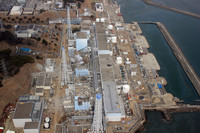Japan Lifts Atomic Alert to Highest Level, Matching Chernobyl

An aerial view of Tokyo Electric Power's Fukushima Dai-Ichi nuclear power plant in Fukushima prefecture, Japan, on March 20, 2011. Source: Air Photo Service via Bloomberg
Japan raised the severity rating of its nuclear crisis to the highest, matching the 1986 Chernobyl disaster, after increasing radiation prompted the government to widen the evacuation zone and aftershocks rocked the country.
Japan’s Nuclear and Industrial Safety Agency today raised the rating to 7. The accident at the Fukushima Dai-Ichi station was previously rated 5 on the global scale, the same as the 1979 partial reactor meltdown at Three Mile Island in Pennsylvania.
The stricken nuclear plant, located about 220 kilometers (135 miles) north of Tokyo, is leaking radiation in Japan’s worst civilian nuclear disaster after a magnitude-9 quake and tsunami on March 11. Tokyo Electric Power Co. said its plant, which has withstood hundreds of aftershocks, may spew more radiation than Chernobyl before the crisis is contained.
“If the leaks continue, the total radiation from the reactors may exceed” that from Chernobyl, Junichi Matsumoto, general manager of one of the utility’s nuclear divisions, said in Tokyo today.
The disaster at the Chernobyl power plant in modern-day Ukraine spewed debris as high as 9 kilometers into the air and released radiation 200 times the volume of the combined bombings of Hiroshima and Nagasaki in 1945, according to a 2006 report commissioned by Europe’s Green Party.
The radiation released so far is estimated to be around 10 percent of that from Chernobyl, Japan’s nuclear safety agency said earlier in a statement. The situation at the station is “severe but stable,” Hidehiko Nishiyama, the agency’s deputy director-general, said at a media briefing.
‘Will Do Our Best’
“We are trying to resolve the situation as soon as possible and will do our best to cool down the reactors and prevent the spread of radioactive substances,” Masataka Shimizu, president of the utility, a statement issued after the severity rating was raised. He also apologized for the accident.
The company’s shares fell 10 percent to close at 450 yen Tokyo. The stock has slumped 79 percent since the crisis began.
Prime Minister Naoto Kan said he has asked Tepco, as the utility is called, to give an assessment of when the company expects to resolve the crisis. “An outlook will be presented soon,” he said at news conference in Tokyo.
Today’s rating change won’t lead to a widening of the evacuation zone beyond the increase announced yesterday, Kenkichi Hirose, an adviser to Kan’s cabinet, said earlier.
Chief Cabinet Secretary Yukio Edano said yesterday that residents of some towns beyond the 20-kilometer evacuation zone around the plant will have a month to move to safer areas.
Accident Rating Scale
“In contrast with Chernobyl, we have been able to avoid direct health risks,” Edano said at a public event in Tokyo today. “The assessment level of 7 may be the same, but in terms of its shape and contents, the process has been different.”
The International Nuclear and Radiological Event Scale rates nuclear accidents in terms of their effects on health and the environment, according to the International Atomic Energy Agency, which helped set up the system. Each of its seven steps represents a ten-fold increase in the severity.
A 7 rating means there has been a “major release of radioactive material with widespread health and environmental effects requiring implementation of planned and extended countermeasures,” according to the INES factsheet.
The assessment is based on the combined severity of the situation at reactor Nos. 1, 2 and 3, Nishiyama of the safety agency said.
‘Beginning To Wake Up’
The government “is at last beginning to wake up to the reality of the scale of the disaster,” said Philip White, International Liaison Officer at the Citizens’ Nuclear Information Center, a Tokyo-based group opposed to atomic energy. “Its belated move to evacuate people from a larger area around the nuclear plant, likewise, is a recognition that the impact on public health is potentially much greater than it first acknowledged.”
The March 11 earthquake, the nation’s strongest on record, and tsunami left about 27,500 dead or missing, according to Japan’s National Police Agency.
Japan was struck by two earthquakes stronger than magnitude 6 today, hindering recovery efforts as workers were temporarily evacuated. The temblors followed a 6.6-magnitude quake yesterday and a magnitude 7.1 aftershock on April 7.
While there was no damage to the Fukushima plant from the recent earthquakes, Tepco’s Matsumoto said disruptions make it difficult to assess when it will achieve cold shutdown of the three damaged reactors. The station has six reactors.
Tepco resumed injecting nitrogen into the No.1 reactor’s containment vessel at 11:34 p.m. yesterday after halting it following yesterday’s temblor, it said in a statement on its website. The operation, which is aimed at preventing hydrogen explosions, is continuing, spokesman Naoyuki Matsumoto said.
Water levels in trenches near reactors Nos. 1, 2 and 3 haven’t changed, according to the statement.
To contact the reporters on this story: Yuji Okada in Tokyo at yokada6@bloomberg.net; Aaron Sheldrick in Tokyo at asheldrick@bloomberg.net; Michio Nakayama in Tokyo at mnakayama4@bloomberg.net
To contact the editor responsible for this story: Amit Prakash at aprakash1@bloomberg.net
©2011 BLOOMBERG L.P. ALL RIGHTS RESERVED. http://www.bloomberg.com